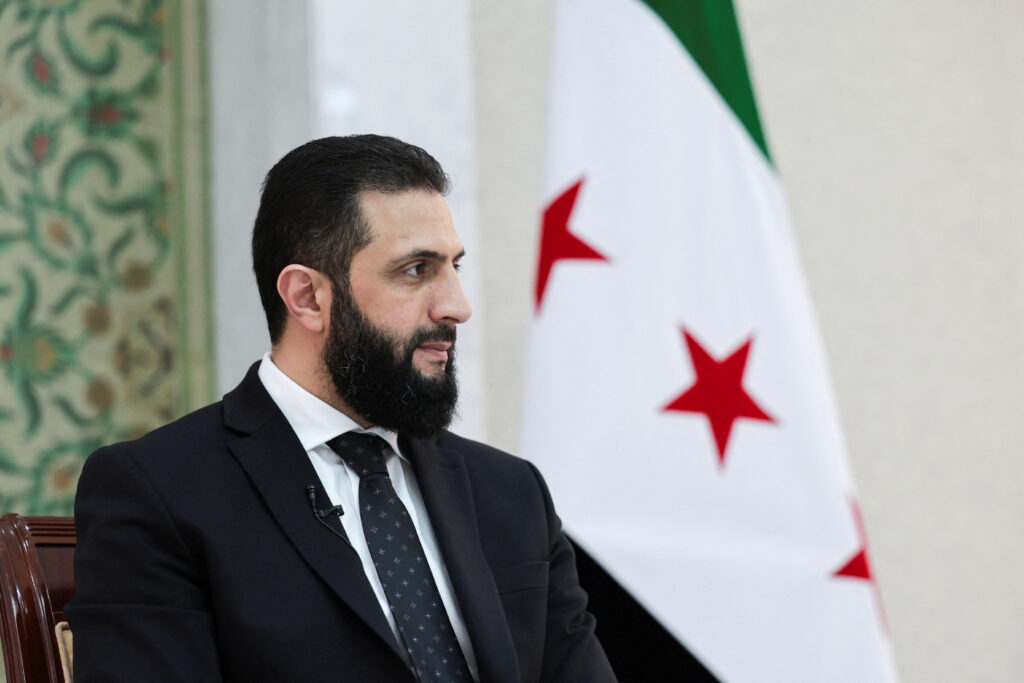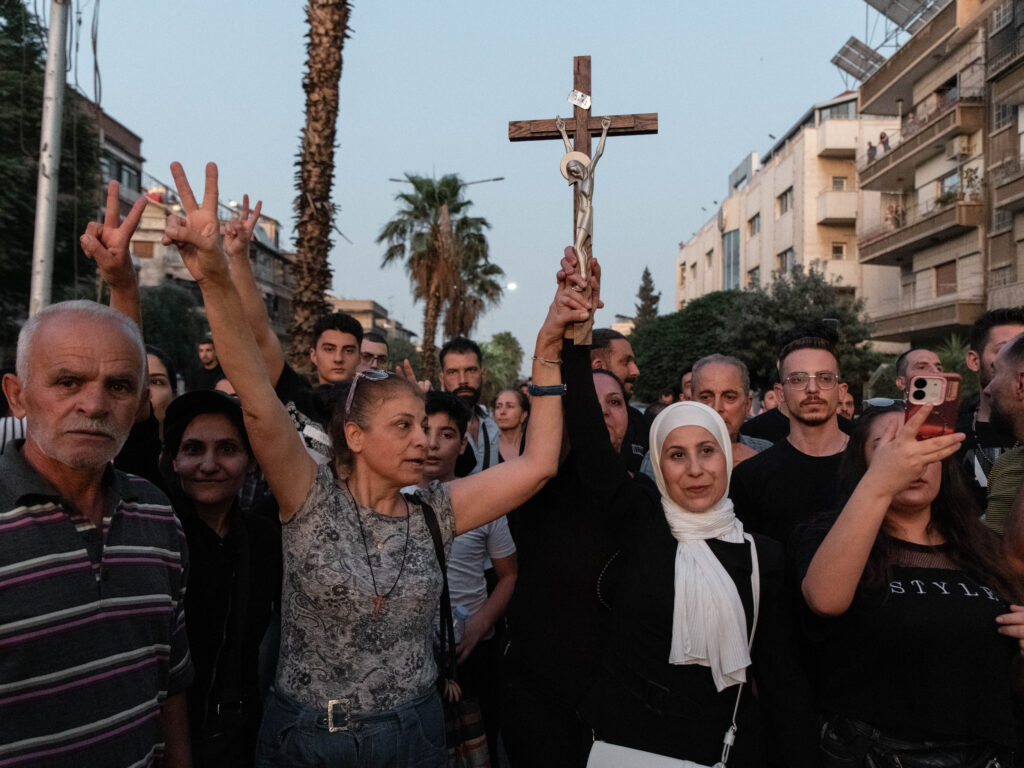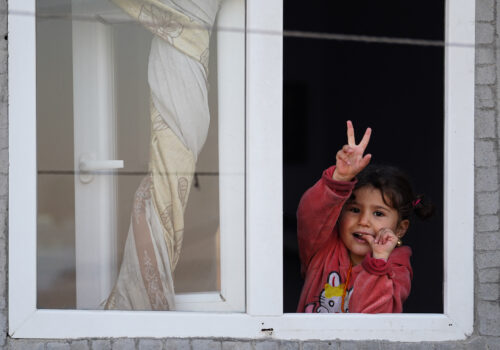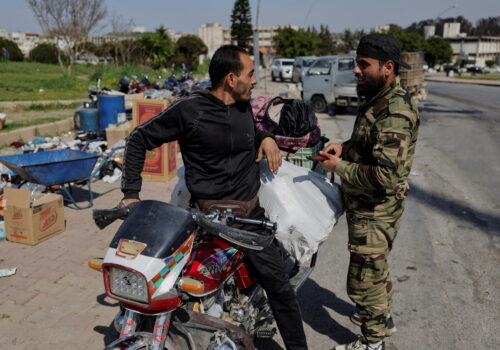DAMASCUS—I was en route from Damascus to Beirut on June 22 when the news began lighting up my phone—messages from friends, notifications, headlines. A bomb had exploded at Mar Elias Church in Damascus during Sunday liturgy, killing twenty-five and injuring dozens more.
The moment I saw the target, I knew this wasn’t just a tragic security breach. It was something more deliberate, a calculated political message. The symbolic targeting of a minority place of worship suggests strategic intent: to fracture communal trust, to challenge the legitimacy of the transitional government, and to signal that no community is off limits. The sequence of recent attacks against Alawites, then Druze, and now Christians reveals a disturbing trend in Syria—and this attack on a Christian church marks an escalation. The perpetrators are sending a message, not only to religious minorities but also to Syria’s cosmopolitan and urban communities: everyone is vulnerable.
The attack raises urgent questions about who controls security in a post-Bashar al-Assad Syria, and whether any community can rely on protection under a new government led by President Ahmed al-Sharaa, formerly of militant opposition group Hayat Tahrir al-Sham (HTS). For the United States and its allies, it’s a warning about the fragility of the transition, and a call to reassess how to support stability.
The attack and its immediate impact
The explosion represents the first mass-casualty terrorist attack in the capital since the fall of the Assad regime. The Syrian Interior Ministry attributed the attack to Islamic State sleeper cells. While this may prove true, many observers questioned the speed of this conclusion, suggesting that either the attack received internal facilitation or that a rush to assign blame masks deeper insecurity.
The Interior Ministry also claimed that authorities captured a second attacker who was allegedly en route to bomb a Shiite shrine in Sayyida Zeinab and thwarted a third operation targeting a crowded civilian area. These reports, if accurate, confirm that the church attack was part of a broader plot targeting both religious minorities and civilians. The Ministry added that the church bomber was not Syrian—but provided no further details.
The targeting of a Christian site, without any claimed justification or provocation, is a stark departure from previous patterns. Earlier attacks had been framed, however cynically, around perceived offenses or political allegiances. The bombing at Mar Elias lacked even that pretext. It was meant to send a broader signal: Syria’s minorities, regardless of their political alignment, remain vulnerable. Moreover, it highlights a chilling possibility that the capital, once considered the most secure part of the country, may no longer offer protection from asymmetric violence.
SIGN UP FOR THIS WEEK IN THE MIDEAST NEWSLETTER
Questions remain about the operational nature of the bombing: Was this an isolated sleeper cell attack? Did it receive external facilitation, or was it enabled, knowingly or not, by elements within Syria’s fragmented security architecture? In Damascus, some observers have quietly raised concerns that the attackers may have passed through compromised checkpoints, or received indirect support from local actors with divided loyalties or limited oversight. These are not yet proven claims, but they reflect a broader anxiety within the transitional government about infiltration, coordination gaps, and the limits of their own control.
Terrorist attacks pose challenges even to the most advanced and capable governments, especially in an era of decentralized threats and lone-wolf actors. Syria’s institutions, still reeling from years of conflict, face an even more daunting task.
Public sentiment and minority concerns
The attack’s immediate aftermath saw an outpouring of grief and solidarity from across the country, but also a palpable rise in fear.
Christian communities, already diminished by years of war and emigration, now face renewed anxiety about their future in Syria. They are not alone. The attack has raised alarm among other religious minorities, as well. Alawite communities in villages along the Syrian coast were recently attacked by armed militants and rogue groups. The violence followed a coordinated assault by remnants of the Assad regime in these areas against government security forces, sparking a wave of sectarian killings and retaliatory violence. Islamist armed groups raided Druze towns in southern Syria, accusing residents of blasphemy and religious violations. Now, Christians are targeted without cause. The trajectory suggests a calculated effort to fracture social cohesion.
Beyond religious identities, urban Sunnis and secular Syrians in cosmopolitan centers also feel exposed. Radical actors, like the Islamic State in Iraq and al-Sham (ISIS), view these communities as equally apostate or impure. There is growing concern that markets, Shia mosques, and other civic gathering places may be next. This is not just a crisis for minorities, it is a threat to Syria’s pluralistic social fabric.
Security sector gaps and government response
The bombing underscores the ongoing disarray in Syria’s security architecture. Assad’s notorious security apparatus, deeply associated with torture, repression, and systemic abuse, was rightly ousted after years of violent conflict. However, no ready force was in place to fill the void. What emerged instead is a fragmented system composed of local militias, ad hoc security bodies, and under-resourced police units. In Damascus, traffic police have recently returned, but many police stations are headed by inexperienced figures, some reportedly former HTS clerics. In my conversations with residents in Damascus, many described these officials generally as well-intentioned but untrained and ineffective.
Al-Sharaa’s interim government has struggled to reassure the public that it can provide security and prevent further attacks. Critics noted the vagueness of his initial statement, and some questioned how quickly officials pointed to ISIS as the culprit.
Al-Sharaa’s statement offered condolences, but little clarity.
“We extend our deepest condolences and sincere sympathy to the families of those who perished in this criminal bombing that affected the entire Syrian people,” he said, emphasizing the need for unity between government and citizens against threats to national security.

He pledged to mobilize all security forces to bring the perpetrators to justice. Yet notably, he did not mention Christians nor name the church that had been attacked. While Damascus now shows more visible patrols, many cities and towns remain dangerously under-secured. This bombing, coming just months after failed protection of Druze communities in Jaramana, suggests that communities around the capital are no longer a guaranteed safe zone.
The attack also deepens concerns among Kurdish and other communities who are already skeptical of relying on Damascus for protection. The question of who provides security is now central to Syria’s evolving social contract. As the state struggles to project competence, local communities may increasingly seek alternative arrangements, further fragmenting the national landscape.
The role of foreign fighters and fragmented armed groups
A sensitive but essential aspect of Syria’s current security reality is the integration of foreign fighters into newly formed national units. Fighters from Uighur, Dagestani, and other transnational networks were brought in during the conflict years and now form part of the pro-government order. But their limited ties to local communities, linguistic and cultural disconnects, and controversial pasts have made them a source of tension.
Though there is no confirmed link between foreign fighters and the Mar Elias bombing, recent public debates in Syria questioned their future role. Integrating such actors into national structures without rigorous vetting, training, and accountability mechanisms risks undermining both legitimacy and effectiveness. According to Syria’s Interior Ministry, the captured cell leader, Mohammad Abdelillah al-Jumaili, had ties to the al-Hol camp in northeastern Syria, where radicalized fighters have been recruited for attacks.
Policymakers in Washington should take note: This is a textbook case of the security dilemma in post-conflict transitions.
The bombing also underscored deeper challenges related to religious discourse in Syria and the need for religious institutional reform. What stood out to me is that the Ministry of Endowments, which oversees mosques and religious messaging, hasn’t been playing an active role or adapting to the moment. During my time in Damascus and Homs, I observed billboards from the ministry advertising Hajj prayers and religious programming, but nothing that spoke to unity, peace, or social solidarity. There is a pressing need for religious institutions to play a constructive role in social reconciliation and counter-radicalization. Reforming the religious establishment so it promotes pluralism rather than silence or sectarianism should be part of any long-term stabilization plan.
Regional and international stakes
The international reaction to the church bombing was swift—including condemnations from the Gulf states, European Union, United States, and Turkey. But condemnation alone is insufficient. The incident poses strategic questions: how can outside actors support Syria’s stabilization without inadvertently empowering abusive or unaccountable structures? Can external aid target inclusive governance, community policing, and deradicalization efforts without becoming enmeshed in domestic rivalries?
For Washington, the attack is a reminder of the unfinished work in Syria. Over the last decade, the US mission in Syria centered on countering ISIS and providing humanitarian aid. The focus must now expand to a broader agenda: supporting institution-building, security sector reform, and inclusive political transition. This shift is especially timely given US President Donald Trump’s active recalibration of Washington’s Syria policy, including new directives that support engagement with transitional actors and coordination on security matters. US officials have acknowledged working with Syrian authorities to track extremist networks and monitor the integration of foreign fighters into new national units, an implicit recognition that security coordination is already underway. Engagement with transitional actors, however messy or imperfect, should be guided by conditionality, partnership, and sustained support.
The bombing at Mar Elias Church is more than an isolated tragedy. It is a strategic signal that Syria’s transition remains vulnerable to sabotage. Without credible, professional security forces, religious reform, and meaningful inclusion of minorities and urban constituencies, Syria risks sliding into a new cycle of fear and fragmentation.
Policymakers in Washington and beyond must act on this warning. Supporting a secure, pluralistic Syria means helping to build the institutions that Assad destroyed, but without replicating his repressive legacy. This is not only a matter of moral clarity. It is a strategic imperative.
Ibrahim Al-Assil is a resident senior fellow for the Syria Project in the Atlantic Council’s Middle East Programs. He is also a professorial lecturer at George Washington University’s Department of Political Science, where he teaches courses on comparative politics and great-power competition.
Further reading
Fri, Jun 20, 2025
On World Refugee Day, complexities persist for Syrian returnees
MENASource By Sinan Hatahet
While Syria's political shift brings new hope, it also highlights the complex realities that still define the Syrian landscape.
Tue, Jun 10, 2025
Why DDR programs are the missing link to Syrian stability
MENASource By
With the end of Western sanctions, Syria faces a rare opportunity to address the imbalances of the post-conflict period.
Wed, May 28, 2025
Sectarianism, social media, and Syria’s information blackhole
MENASource By
Since Assad’s December ousting, Syrians have struggled to sift the truth from fake claims about security incidents across the country.
Image: A procession of Syrians marches through the streets of Damascus following the commemorations organized in the Mar Elias church the day after a suicide bombing killed 25 people and wounded more than 60 on Sunday June 22. Demonstrators marched forward chanting slogans such as “Mother of martyrs, we are your sons” and “Christians, hold your heads high”. According to the Syrian authorities, the perpetrator of the attack was a member of Daech. President Ahmed al-Sharaa declared three days of national mourning. Damascus, Syria, June 22, 2025. Un cortege de syriens marche dans les rues de Damas a la suite des commemorations organisees dans l’eglise Mar Elias au lendemain d’un attentat suicide ayant fait 25 morts et plus de 60 blesses, le dimanche 22 juin, dans l’eglise Mar Elias. Les manifestants avancent en scandant differents slogans “Mere des martyrs, nous sommes tes fils” ou encore “chretiens gardez la tete haute”. Selon les autorites syriennes, l’auteur de l’attaque serait un membre de Daech. Le president Ahmed al-Sharaa a decrete trois jours de deuil national. Damas, Syrie, 22 juin 2025.




